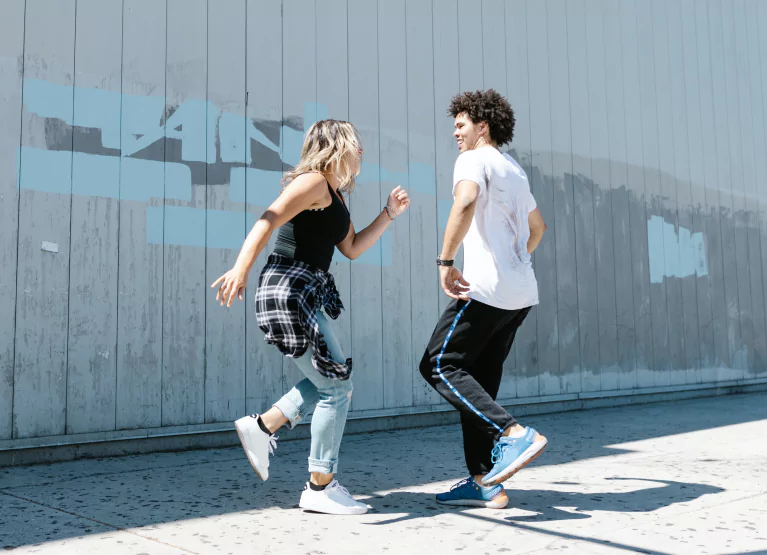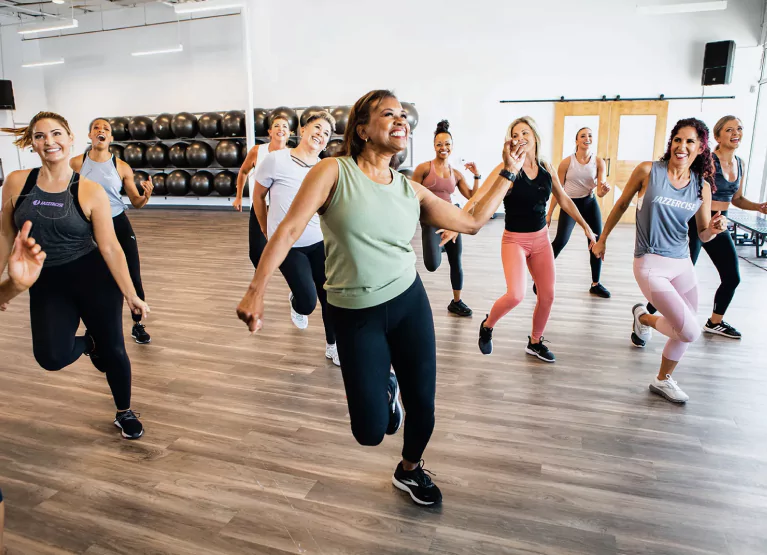7 Dancing Styles for Weight Loss
.webp)
Key Takeways
If you’ve read our other blogs on weight loss, you’ll know that strength training and aerobic cardio exercise are great tools for weight management and other health benefits.
There are many different ways to increase your cardio exercise, from running to swimming, cycling, and even HIIT exercise. Although it may seem surprising, dancing can also be another fun way and enjoyable way to get your heart rate up!
In this article, we’ll explore seven different dance styles, the health benefits they can provide, and a few tips to start dancing to your target weight.
Health Benefits of Dancing
Dancing is a type of aerobic exercise and can be a great way to add more cardio to your routine. However, there are many types of dance, and each style may have unique benefits.
Research has shown that increased levels of exercise (from activities such as dancing) may lead to reduced risk of cardiovascular disease, lower risk of premature death, and improved wellbeing. In addition to the positive effects on cardiovascular health, short term aerobic exercise like dancing can improve brain health and cognitive function.
In a 2013 study, researchers found that aerobic exercise was effective at reducing age-related cognitive decline in memory and executive function by increasing the blood flow to the brain.
Other studies also show that physical activity also improves brain function by altering the brain structurally and functionally.
Along with all these potential benefits, aerobic exercise has also been shown to improve mental health and mood. Studies have found a strong link between cardio, including dancing, and reduced depression and anxiety.
Certain types of dances may have more specific health benefits as well. Ballet dancing, for example, can be incredibly effective at strengthening the core and may even help improve balance. Ballet may also boost mental health and self-concept for aging adults.
Other forms of dancing may improve muscle performance in older adults. People who dance regularly have also been found to have better posture and flexibility.
How Dancing Can Help with Weight Loss

Like other forms of cardiovascular exercise, regularly participating in dancing classes or sessions can help you increase your level of physical activity. One study done in over 100 individuals who were classified as obese or overweight showed that cardio exercise alone resulted in significant weight loss.
Interestingly, these individuals lost weight despite the fact that they did not restrict their calories. In this study, there were also no significant differences in weight loss between men and women, suggesting that cardio can be beneficial regardless of gender.
Some dance classes incorporate high intensity interval training, or HIIT, into their routine, which can be effective for weight loss. HIIT may influence factors associated with energy metabolism in the cell, which could potentially influence metabolic rate, though more research is needed to explore this connection further.
How to Incorporate Dancing into Your Routine
To get the most out of your exercising, you’ll want to learn a dance style of your choice or follow along with a dance instructor. However, remember that when you begin a new workout routine, it's always advised that you speak with your doctor.Here are some easy ways to incorporate dancing into your routine.
Check Out Your Local Gym for Dance Classes
This may be the most straightforward and easiest way to get a jump start on dancing. Many gyms offer group classes like zumba or a dance-focused HIIT.
Regardless of which form of dance you prefer, make sure to choose a class that you enjoy. Gym classes usually last around 45 to 60 minutes, although some can extend a little bit beyond that.
Check Your Local Studio For Specific Dance Styles

There are lots of studios dedicated to dance classes. These studios may have more varieties, and may even introduce you to unique dance styles you may have never heard of before.
If you’re looking for an out-of-the-box experience or are interested in traditional dance styles, a local studio is your best bet. Like gym classes, these classes are also usually around 60 minutes long.
Find A Dance Instructor On Youtube Or Other Online Platforms
Finding dance instructors or classes online is a very flexible option and allows you to experience dancing on your own schedule. If you’re nervous about attending an in-person class or prefer to start in the comfort of your own home, an online platform is a great option. While searching for videos on your preferred dance style, it may be a good idea to choose one from a certified instructor.
Find Dancing Events In Your Area…and Bring a Friend!
If you want to focus on the fun part of dancing, or want to put all your dance practice from class into action, a local dance event or outdoor class may be just the right way to go. Bring a friend or your partner to hold yourself accountable and enjoy the experience.
7 Dancing Styles for Weight Loss

By now, you may be all fired up and ready to go dancing for those health benefits. If that sounds like you, here are seven different dancing styles to consider.
Ballet
Ballet is a performance dance that first started during the Italian renaissance in the 1400s. This type of dance involves highly choreographed and curated movements that tell a story.
Along with improving core strength, balance, and flexibility, ballet can improve overall physical and psychological well being. The benefits of ballet for weight loss may depend on many factors, including the amount of time you spend doing it, your overall metabolic health, and your weight.
Belly Dancing

Belly dancing is a dance style that is native to North Africa, the Middle East, and Central Asia, and has been around for centuries. Like ballet, this dance is used expressively and usually tells a story.
Belly dancing involves artistic, fluid movements of the core, hips, and lower limbs. Apart from getting your heart rate up, one study found that belly dancing can improve symptoms of pain in women with chronic low back pain by improving core and pelvic structure and function.
Another study found that not only was belly dancing a beneficial option for women with breast cancer, but it improved mood, fatigue, and overall quality of life for these women. Again, the calories you burn during a session of belly dancing will depend on your weight, body composition, and other factors.
Hip Hop
Hip hop dancing is a street dance style that emerged through the 1970s in urban America. Like other forms of cardio, hip hop can increase physical activity and help to burn calories. One review found evidence to suggest that hip hop can be an effective exercise intervention for obese or overweight individuals.
This dance style has also been used to promote health literacy and benefits of dancing and physical activity, however research suggests that more studies are needed to determine the long-term effectiveness.
Zumba

Zumba is a popular dance style that is taught at many gyms and dance studios. It’s also a great option for beginners who want to dip their toes into dancing. This dance style involves jumping, rhythmic movements, and coordination between different muscle groups.
The benefits of zumba dancing have been well documented in research. One review found that the health benefits of zumba can include:
- Increasing aerobic exercise
- Supporting weight loss
- Helping to improve body composition
- Supporting psychological and social well being
Salsa Dancing
Salsa, like zumba, is also a popular dance style. This dance style first originated in Cuba during the early 1900s before spreading to other regions such as Spain, Africa, and the Caribbean. Research has shown numerous health benefits for salsa dancing such as:
- Static and dynamic postural improvements (helps to reduce risk of falls and slips)
- Increased physical activity
- Improved physical fitness and reduced risk for cardiovascular disease
- Faster walking in older adults
Jazzercise

Jazzercise is a newer dance style that combines the best of aerobic activity, HIIT cardio, and dance fitness.
Because it’s relatively new, it hasn’t been studied as deeply as other forms of dance. However, this type of movement can be considered a high intensity exercise, meaning it may help build muscle and support improved energy metabolism in the cell.
Pole Dancing
You may already be familiar with pole dancing, but may not know this is a competitive sport for some people. This type of dancing requires a lot of muscle strength, balance, coordination, and agility. Research shows that pole dancers benefit from:
- Less body fat
- Greater muscular strength
- Better lower back and hamstring flexibility
- More upper body musculature
However, it’s important to note that the same study also noted that pole dancers are more prone to injuries. Female pole dancers may also be more likely to experience menstrual irregularities, so you may want to consult with a medical provider if you’re participating in this activity regularly.
{{rich-text-cta-wl2="/style-guide"}}
Potential Risks to Watch Out For With Dancing

While dancing can be fun and great for your wellbeing, there are some risks to be aware of. These include (but may not be limited to):
- Risk of stress fractures
- Foot and ankle injuries, especially for dance styles that rely on heavy footwork
- Overuse injuries
- Exacerbate joint pain and/or pre-existing arthritis
- Lower back pain if strength and flexibility is imbalanced and/or poor
These risks may depend on the style of dance you partake in. You may want to visit a physical therapist to discuss injury prevention and proper form during dance classes or training.
Find the right Nutrisense programto turn insight into progress.
Go Beyond Glucose Data with Nutrisense
Your glucose can significantly impact how your body feels and functions. That’s why stable levels are an important factor in supporting overall wellbeing. But viewing glucose isn't enough. Nutrisense, you’ll be able to learn how to use your body's data to make informed lifestyle choices that support healthy living.
One-to-one coaching
Sign up to access insurance-covered video calls to work with a glucose expert: a personal registered dietitian or certified nutritionist who will help tailor your lifestyle and diet to your goals.
Monitor and measure what matters
With the Nutrisense CGM Program, you can monitor your glucose with health tech like glucose biosensors and continuous glucose monitor (CGM)s, and analyze the trends over time with the Nutrisense App. This will help you make the most informed choices about the foods you consume and their impact on your health.
Find your best fit
Ready to take the first step? Start with our quiz to find the right Nutrisense program to help you take control.

Heather is a Registered and Licensed Dietitian Nutritionist (RDN, LDN), subject matter expert, and technical writer, with a master's degree in nutrition science from Bastyr University. She has a specialty in neuroendocrinology and has been working in the field of nutrition—including nutrition research, education, medical writing, and clinical integrative and functional nutrition—for over 15 years.




